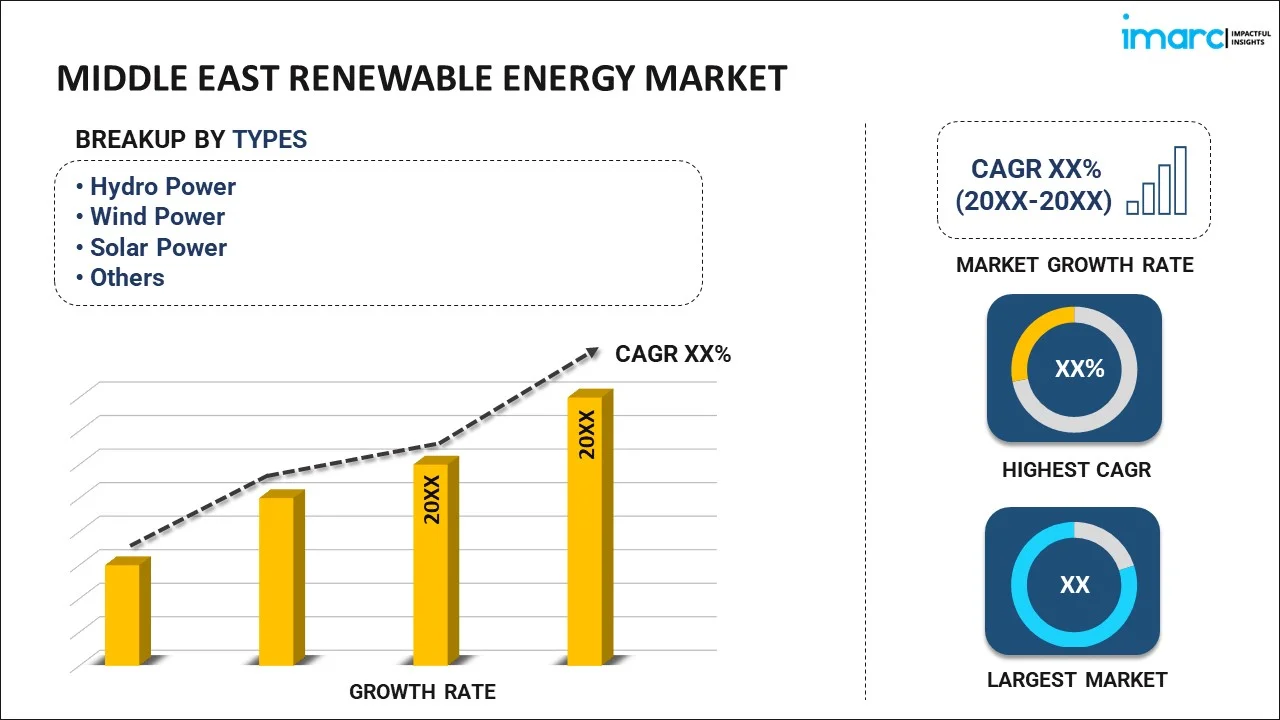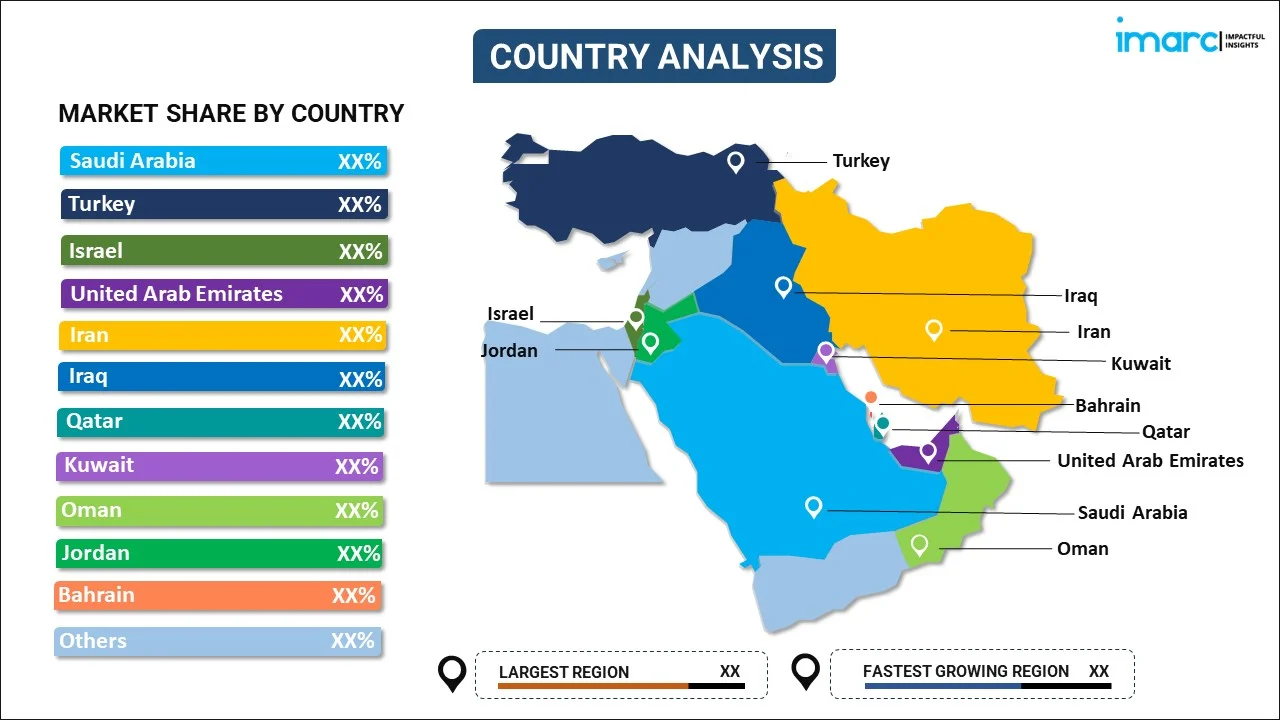
Middle East Renewable Energy Market Report by Type (Hydro Power, Wind Power, Solar Power, Bioenergy, and Others), End User (Industrial, Residential, Commercial), and Country 2024-2032
Market Overview:
Middle East renewable energy market size is projected to exhibit a growth rate (CAGR) of 13.53% during 2024-2032. The growing shift from centralized power generation to a more distributed mode, increasing cost-effectiveness of solar panels and wind turbines, and rising improvements in solar photovoltaics, energy storage systems, and smart grid technologies represent some of the key factors driving the market.
|
Report Attribute
|
Key Statistics
|
|---|---|
|
Base Year
|
2023 |
|
Forecast Years
|
2024-2032
|
|
Historical Years
|
2018-2023
|
| Market Growth Rate (2024-2032) | 13.53% |
Renewable energy refers to power derived from resources that are naturally replenished on a human timescale. It comprises solar, wind, hydroelectric, and geothermal energy, which is generated from the heat produced by the surfaces of the earth. It also includes biomass energy, which is obtained from various organic materials like wood or crop waste. It is virtually inexhaustible, ensuring a long-term and sustainable energy supply for future generations. It produces minimal or no greenhouse gas emissions during operation, reducing the carbon footprint and mitigating climate change. It is sustainable and clean and helps combat global warming. Renewable energy also assists in diversifying the energy mix of various countries to reduce reliance on imported fossil fuels, enhancing national security. It helps to improve the air quality by lowering the presence of various particulate matter and harmful gases, primarily produced by the burning of fossil fuels. It also helps to prevent water pollution and the destruction of marine life. It facilitates the preservation of ecosystems and contributes to a cleaner and healthier environment. It creates jobs, stimulates economic growth, and fosters innovation in technology and infrastructure. It also empowers communities and individuals by providing access to energy in remote areas, fostering energy independence.
Middle East Renewable Energy Market Trends:
At present, the increasing awareness about the importance of using renewable energy and minimizing the expenditure of fossil fuels represents one of the crucial factors impelling the growth of the market in the Middle East. Besides this, governing agencies in the region are implementing a range of measures, including subsidies, tax credits, and feed-in tariffs, to encourage investment in renewable energy projects. The stringent environmental regulations and emissions targets are also compelling businesses to prioritize renewable energy sources in their energy portfolios. In addition, the growing improvements in solar photovoltaics, wind turbine efficiency, energy storage systems, and smart grid technologies are enhancing the feasibility and cost-effectiveness of renewable energy solutions. The maturation of these technologies contributes to reducing the levelized cost of electricity (LCOE) associated with renewable sources, making them competitive with traditional fossil fuels. Apart from this, the cost-effectiveness of solar panels and wind turbines, coupled with improvements in energy conversion efficiency, is leading to a substantial reduction in the overall cost of renewable energy generation. Businesses and utilities are recognizing the economic benefits of investing in renewable energy. Additionally, corporate power purchase agreements (PPAs) for renewable energy projects are becoming common, providing a stable revenue stream for developers and encouraging further investment in renewable infrastructure. Moreover, the increasing shift from centralized power generation to a more distributed model, facilitated by advancements in microgrid technology and energy storage, allows for greater integration of renewable sources. This decentralization also enhances energy security, reduces transmission and distribution losses, and enables communities to become more self-sufficient in meeting their energy needs.
Middle East Renewable Energy Market Segmentation:
IMARC Group provides an analysis of the key trends in each segment of the market, along with forecasts at the regional and country levels for 2024-2032. Our report has categorized the market based on type and end user.
Type Insights:

- Hydro Power
- Wind Power
- Solar Power
- Bioenergy
- Others
The report has provided a detailed breakup and analysis of the market based on the type. This includes hydro power, wind power, solar power, bioenergy, and others.
End User Insights:
- Industrial
- Residential
- Commercial
A detailed breakup and analysis of the market based on the end user have also been provided in the report. This includes industrial, residential, and commercial.
Country Insights:

- Saudi Arabia
- Turkey
- Israel
- United Arab Emirates
- Iran
- Iraq
- Qatar
- Kuwait
- Oman
- Jordan
- Bahrain
- Others
The report has also provided a comprehensive analysis of all the major regional markets, which include Saudi Arabia, Turkey, Israel, United Arab Emirates, Iran, Iraq, Qatar, Kuwait, Oman, Jordan, Bahrain, and Others.
Competitive Landscape:
The market research report has also provided a comprehensive analysis of the competitive landscape in the market. Competitive analysis such as market structure, key player positioning, top winning strategies, competitive dashboard, and company evaluation quadrant has been covered in the report. Also, detailed profiles of all major companies have been provided.
Middle East Renewable Energy Market Report Coverage:
| Report Features | Details |
|---|---|
| Base Year of the Analysis | 2023 |
| Historical Period | 2018-2023 |
| Forecast Period | 2024-2032 |
| Units | US$ Million |
| Scope of the Report | Exploration of Historical and Forecast Trends, Industry Catalysts and Challenges, Segment-Wise Historical and Predictive Market Assessment:
|
| Types Covered | Hydro Power, Wind Power, Solar Power, Bioenergy, Others |
| End Users Covered | Industrial, Residential, Commercial |
| Countries Covered | Saudi Arabia, Turkey, Israel, United Arab Emirates, Iran, Iraq, Qatar, Kuwait, Oman, Jordan, Bahrain, Others |
| Customization Scope | 10% Free Customization |
| Report Price and Purchase Option | Single User License: US$ 3699 Five User License: US$ 4699 Corporate License: US$ 5699 |
| Post-Sale Analyst Support | 10-12 Weeks |
| Delivery Format | PDF and Excel through Email (We can also provide the editable version of the report in PPT/Word format on special request) |
Key Questions Answered in This Report:
- How has the Middle East renewable energy market performed so far and how will it perform in the coming years?
- What has been the impact of COVID-19 on the Middle East renewable energy market?
- What is the breakup of the Middle East renewable energy market on the basis of type?
- What is the breakup of the Middle East renewable energy market on the basis of end user?
- What are the various stages in the value chain of the Middle East renewable energy market?
- What are the key driving factors and challenges in the Middle East renewable energy?
- What is the structure of the Middle East renewable energy market and who are the key players?
- What is the degree of competition in the Middle East renewable energy market?
Key Benefits for Stakeholders:
- IMARC’s industry report offers a comprehensive quantitative analysis of various market segments, historical and current market trends, market forecasts, and dynamics of the Middle East renewable energy market from 2018-2032.
- The research report provides the latest information on the market drivers, challenges, and opportunities in the Middle East renewable energy market.
- Porter's five forces analysis assist stakeholders in assessing the impact of new entrants, competitive rivalry, supplier power, buyer power, and the threat of substitution. It helps stakeholders to analyze the level of competition within the Middle East renewable energy industry and its attractiveness.
- Competitive landscape allows stakeholders to understand their competitive environment and provides an insight into the current positions of key players in the market.
Need more help?
- Speak to our experienced analysts for insights on the current market scenarios.
- Include additional segments and countries to customize the report as per your requirement.
- Gain an unparalleled competitive advantage in your domain by understanding how to utilize the report and positively impacting your operations and revenue.
- For further assistance, please connect with our analysts.
 Inquire Before Buying
Inquire Before Buying
 Speak to an Analyst
Speak to an Analyst
 Request Brochure
Request Brochure
 Request Customization
Request Customization




.webp)




.webp)












